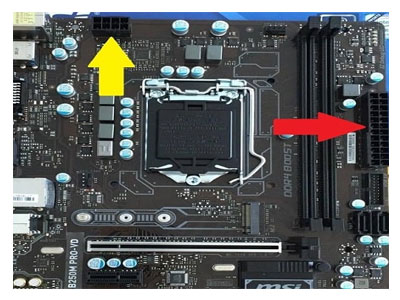Key Takeaway
To connect power supply cables, follow these steps: First, ensure the power is off to avoid any electrical hazards. Identify the positive and negative cables. Usually, the red cable is positive, and the black one is negative. Connect the red cable to the positive terminal and the black cable to the negative terminal. Use a screwdriver to secure the connections tightly. Double-check the connections to ensure they are firm. Finally, turn the power back on and test the connection. This ensures safe and reliable power supply cable connections.
Types of Power Supply Cables
Power supply cables come in various types, each designed for specific applications. The most common types include:
Single-Core Cables: These are used for simple, low-power connections. They consist of a single conductor.
Multi-Core Cables: These have multiple conductors and are used for more complex connections, such as in control panels.
Armored Cables: These cables have a protective layer and are used in harsh environments to prevent damage.
Flexible Cables: Often used in applications where the cable needs to move, such as in machinery with moving parts.
Selecting the right cable is crucial for safety and performance. Consider the application’s power requirements and environmental conditions when choosing a cable.

Tools and Safety Precautions
Before diving into any electrical project, it’s crucial to gather the right tools and ensure all safety precautions are firmly in place. This preparation can make the difference between a smooth operation and a hazardous situation. The essential tools you’ll need include wire strippers, screwdrivers, crimping tools, and a multimeter.
Wire strippers are used to remove the insulation from the cable ends, ensuring a clean connection. Screwdrivers are vital for securing these connections, while crimping tools help attach connectors to the cable ends efficiently. The multimeter is indispensable for checking voltage and continuity, ensuring everything is correctly connected.
Safety should always be your top priority. Always turn off the power supply before starting any work to avoid electric shocks. Wearing insulated gloves and eye protection can protect you from potential injuries. Additionally, ensure that all tools are in good condition and suitable for the job. Following these precautions can help you avoid common hazards and ensure a safe working environment. By having the right tools and adhering to safety protocols, you lay the foundation for a successful and secure electrical project, preventing mishaps and ensuring smooth operations.
You May Like to Read
Step-by-Step Connection Guide
Making secure electrical connections requires a methodical approach. Here’s a detailed guide to help you through the process.
Firstly, ensure the power supply is completely turned off before starting. This step is crucial to prevent any accidental shocks. Next, prepare your cables by using wire strippers to remove about 1-2 cm of insulation from the cable ends. This preparation allows for a clean and effective connection.
Then, use crimping tools to attach the appropriate connectors to the cable ends. This step is essential for a secure connection. Once the connectors are in place, insert the cable ends into the appropriate terminals or connectors on the power supply. Secure them firmly with a screwdriver.
After connecting, use a multimeter to check for any short circuits and ensure that all connections are secure. Once everything is in place, turn on the power supply and check for correct operation. Following these steps meticulously ensures a safe and effective connection, minimizing the risk of electrical faults and ensuring the reliability of the system.
Common Mistakes to Avoid
Avoiding common mistakes can significantly improve the reliability and safety of your electrical connections. One common error is inadequate stripping of the cable insulation. Not stripping enough can prevent proper connections, while stripping too much can expose conductors and cause short circuits.
Loose connections are another frequent issue. They can lead to overheating and even electrical fires. Always ensure that all connections are tight and secure. Using the wrong type of cable can also cause problems. It can result in insufficient power delivery or even damage to the cable. Ignoring safety precautions is perhaps the most dangerous mistake. Skipping steps like turning off the power or wearing protective gear can lead to serious accidents and injuries.
By being mindful of these mistakes, you can ensure a safer and more effective connection process. This mindfulness can also help in maintaining the integrity of the electrical system and preventing future issues, ensuring that your projects are not only successful but also safe and reliable.
Ensuring Secure Connections
Secure connections are the backbone of reliable electrical operations. Here are some tips to ensure your connections are robust and dependable.
Firstly, always double-check the tightness of all screws and connectors after making a connection. Loose connections can cause significant problems, including overheating and electrical fires. Using the proper connectors for your cables is also crucial. Ensure they are the correct type and size for the job. This attention to detail can prevent connection failures and ensure a secure fit.
Regular inspections are also essential. Periodically check your connections for signs of wear, corrosion, or loosening. This proactive approach can help you catch and fix potential issues before they become major problems. Lastly, always test your connections with a multimeter. This tool can check for correct voltage and continuity, ensuring there are no hidden faults. By following these tips, you can maintain secure and reliable connections, minimizing downtime and maintenance issues, and ensuring the safety and efficiency of your electrical system.
Conclusion
Connecting power supply cables is a crucial task that requires attention to detail and adherence to safety protocols. By understanding the types of cables, using the right tools, following a step-by-step guide, avoiding common mistakes, and ensuring secure connections, you can achieve reliable and safe electrical connections. Remember, safety first and always double-check your work to prevent any potential issues.
